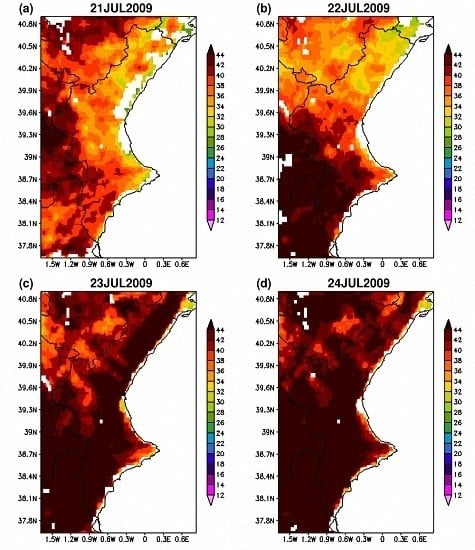Impact of Initial Soil Temperature Derived from Remote Sensing and Numerical Weather Prediction Datasets on the Simulation of Extreme Heat Events
Abstract
:1. Introduction
2. Data and Methodology
2.1. RAMS Model
2.2. Incorporation of Analysis LST and ST
2.3. Incorporation of the MSG-SEVIRI LST
2.4. Sensitivity Experiments
2.5. Observational Datasets and Evaluation Procedure
3. Meteorological Description of the Event
4. Results
4.1. Daily Maximum and Minimum Temperatures
4.2. Wind, Temperature and Moisture Dynamics
4.2.1. Horizontal Observed and Simulated Patterns
4.2.2. Vertical Observed and Simulated Patterns
5. Conclusions
Acknowledgments
Author Contributions
Conflicts of Interest
References
- IPCC. Climate Change 2014: Impacts, Adaptation and Vulnerability; Working Group II Contribution to the Intergovernmental Panel on Climate Change Fifth Assessment Report (WGII AR5) 2014; Summary for Policymakers (SPM); IPCC: Geneva, Switzerland, 2014. [Google Scholar]
- Easterling, D.R. Maximum and minimum temperature trends for the globe. Science 1997, 277, 364–367. [Google Scholar] [CrossRef]
- Easterling, D.R.; Meehl, G.A.; Parmesan, C.; Changnon, S.A.; Karl, T.R.; Mearns, L.O. Climate extremes: Observations, modeling, and impacts. Science 2000, 289, 2068–2074. [Google Scholar] [CrossRef] [PubMed]
- Miró, J.J.; Estrela, M.J.; Millán, M. Summer temperature trends in a Mediterranean area (Valencia Region). Int. J. Climatol. 2006, 26, 1051–1073. [Google Scholar] [CrossRef]
- Della-Marta, P.M.; Haylock, M.R.; Luterbacher, J.; Wanner, H. Doubled length of Western European summer heat waves since 1880. J. Geophys. Res. 2007. [Google Scholar] [CrossRef]
- Stéfanon, M.; Drobinski, P.; D’Andrea, F.; Lebeaupin-Brossier, C.; Bastin, S. Soil moisture-temperature feedbacks at meso-scale during summer heat waves over Western Europe. Clim. Dyn. 2013, 42, 1309–1324. [Google Scholar] [CrossRef]
- Miró, J.; Estrela, M.J.; Olcina-Cantos, J. Statistical downscaling and attribution of air temperature change patterns in the Valencia region (1948–2011). Atmos. Res. 2015, 156, 189–212. [Google Scholar] [CrossRef]
- Fischer, E.M.; Schär, C. Consistent geographical patterns of changes in high-impact European heatwaves. Nat. Geosci. 2010, 3, 398–403. [Google Scholar] [CrossRef]
- El Kenawy, A.; López-Moreno, J.I.; Vicente-Serrano, S.M. Recent trends in daily temperature extremes over northeastern Spain (1960–2006). Nat. Hazards Earth Syst. 2011, 11, 2583–2603. [Google Scholar] [CrossRef]
- El Kenawy, A.; López-Moreno, J.I.; Vicente-Serrano, S.M. Trend and variability of surface air temperature in northeastern Spain (1920–2006): Linkage to atmospheric circulation. Atmos. Res. 2012, 106, 159–180. [Google Scholar] [CrossRef]
- Fernández-Montes, S.; Rodrigo, F.S. Trends in seasonal indices of daily temperature extremes in the Iberian Peninsula, 1929–2005. Int. J. Climatol. 2012, 32, 2320–2332. [Google Scholar] [CrossRef]
- Acero, F.J.; García, J.A.; Gallego, M.C.; Parey, S.; Dacunha-Castelle, D. Trends in summer extreme temperatures over the Iberian Peninsula using nonurban station data. J. Geophys. Res. Atmos. 2014, 119, 39–53. [Google Scholar] [CrossRef]
- Fonseca, D.; Carvalho, M.J.; Marta-Almeida, M.; Melo-Gonçalves, P.; Rocha, A. Recent trends of extreme temperature indices for the Iberian Peninsula. Phys. Chem. Earth 2015. [Google Scholar] [CrossRef]
- Fischer, E.M.; Seneviratne, S.I.; Lüthi, D.; Schär, C. Contribution of land-atmosphere coupling to recent European summer heat waves. Geophys. Res. Lett. 2007. [Google Scholar] [CrossRef]
- Fischer, E.M.; Seneviratne, S.I.; Vidale, P.L.; Lüthi, D.; Schär, C. Soil moisture-atmosphere interactions during the 2003 European summer heat wave. J. Clim. 2007, 20, 5081–5099. [Google Scholar] [CrossRef]
- Teuling, A.J.; Seneviratne, S.I.; Stäckli, R.; Reichstein, M.; Moors, E.; Ciais, P.; Luyssaert, S.; van den Hurk, B.; Ammann, C.; Bernhofer, C.; et al. Contrasting response of European forest and grassland energy exchange to heatwaves. Nat. Geosci. 2010, 3, 722–727. [Google Scholar] [CrossRef]
- Stéfanon, M.; D’Andrea, F.; Drobinski, P. Heatwave classification over Europe and the Mediterranean region. Environ. Res. Lett. 2012. [Google Scholar] [CrossRef]
- Stéfanon, M.; Drobinski, P.; D’Andrea, F.; Noblet-Ducoudré, N. Effects of interactive vegetation phenology on the 2003 summer heat waves. J. Geophys. Res. Atmos. 2012. [Google Scholar] [CrossRef]
- Dasari, H.P.; Salgado, R.; Perdigao, J.; Challa, V.S. A regional climate simulation study using WRF-ARW model over Europe and evaluation for extreme temperature weather events. Int. J. Atmos. Sci. 2014. [Google Scholar] [CrossRef]
- Dasari, H.; Pozo, I.; Ferri-Yáñez, F.; Araújo, M. A regional climate study of heat waves over the Iberian Peninsula. Atmos. Clim. Sci. 2014, 4, 841–853. [Google Scholar] [CrossRef]
- Piñol, J.; Terradas, J.; Lloret, F. Climatic warning hazard and wildfire occurrence in coastal eastern Spain. Clim. Chang. 1998, 38, 345–357. [Google Scholar] [CrossRef]
- Gómez-Tejedor, J.A.; Estrela, M.J.; Millán, M.M. A mesoscale model application to fire weather winds. Int. J. Wildland Fire 1999, 9, 255–263. [Google Scholar] [CrossRef]
- Hernandez, C.; Drobinski, P.; Turquety, S. Impact of wildfire-induced land cover modification on local meteorology: A sensitivity study of the 2003 wildfires in Portugal. Atmos. Res. 2015, 164–165, 49–64. [Google Scholar] [CrossRef]
- Rodríguez-Puebla, C.; Encinas, A.H.; García-Casado, L.A.; Nieto, S. Trends in warm days and cold nights over the Iberian Peninsula: Relationships to large-scale variables. Clim. Chang. 2010, 100, 667–684. [Google Scholar] [CrossRef]
- Sánchez-Lorenzo, A.; Pereira, P.; Lopez-Bustins, J.A.; Lolis, C.J. Summer night-time temperature trends on the Iberian Peninsula and their connection with large-scale atmospheric circulation patterns. Int. J. Climatol. 2011, 32, 1326–1335. [Google Scholar] [CrossRef]
- Del Río, S.; Cano-Ortiz, A.; Herrero, L.; Penas, A. Recent trends in mean maximum and minimum air temperatures over Spain (1961–2006). Theor. Appl. Climatol. 2012, 109, 605–626. [Google Scholar] [CrossRef]
- El Kenawy, A.; López-Moreno, J.I.; Brunsell, N.A.; Vicente-Serrano, S.M. Anomalously severe cold nights and warm days in northeastern Spain: Their spatial variability, driving forces and future projections. Glob. Planet Chang. 2012, 101, 12–32. [Google Scholar] [CrossRef]
- Brunet, M.; Jones, P.D.; Sigró, J.; Saladié, O.; Aguilar, E.; Moberg, A.; Della-Marta, P.M.; Lister, D.; Walther, A.; López, D. Temporal and spatial temperature variability and change over Spain during 1850–200. J. Geophys. Res. 2007. [Google Scholar] [CrossRef]
- García-Herrera, R.; Díaz, J.; Trigo, R.M.; Hernández, E. Extreme summer temperatures in Iberia: Health impacts and associated synoptic conditions. Ann. Geophys. 2005, 23, 239–251. [Google Scholar] [CrossRef]
- Azorin-Molina, C.; Chen, D. A climatological study of the influence of synoptic-scale flows on sea breeze evolution in the Bay of Alicante (Spain). Theor. Appl. Climatol. 2009, 96, 249–260. [Google Scholar] [CrossRef]
- Azorin-Molina, C.; Chen, D.; Tijm, S.; Baldi, M. A multi-year study of sea breezes in a Mediterranean coastal site: Alicante (Spain). Int. J. Climatol. 2011, 31, 468–486. [Google Scholar] [CrossRef]
- Gómez, I.; Caselles, V.; Estrela, M.J.; Niclòs, R. RAMS-forecasts comparison of typical summer atmospheric conditions over the Western Mediterranean coast. Atmos. Res. 2014, 145–146, 130–151. [Google Scholar] [CrossRef]
- Gómez, I.; Caselles, V.; Estrela, M.J. Verification of the RAMS-based operational weather forecast system in the Valencia Region: A seasonal comparison. Nat. Hazards 2015, 75, 1941–1958. [Google Scholar] [CrossRef]
- Gómez, I.; Estrela, M.J.; Caselles, V. Impacts of soil moisture content on simulated mesoscale circulations during the summer over eastern Spain. Atmos. Res. 2015, 164–165, 9–26. [Google Scholar] [CrossRef]
- Gómez, I.; Estrela, M.J.; Caselles, V. Operational forecasting of daily summer maximum and minimum temperatures in the Valencia Region. Nat. Hazards 2014, 70, 1055–1076. [Google Scholar] [CrossRef]
- Gómez, I.; Caselles, V.; Estrela, M.J. Real-time weather forecasting in the western Mediterranean Basin: An application of the RAMS model. Atmos. Res. 2014, 139, 71–89. [Google Scholar] [CrossRef]
- Cotton, W.R.; Pielke, R.A.S.; Walko, R.L.; Liston, G.E.; Tremback, C.J.; Jiang, H.; McAnelly, R.L.; Harrington, J.Y.; Nicholls, M.E.; Carrio, G.G.; et al. RAMS 2001: Current status and future directions. Meteorol. Atmos. Phys. 2003, 82, 5–29. [Google Scholar] [CrossRef]
- Pielke, R.A.S. Mesoscale Meteorological Modeling, 3rd ed.; Academic Press: San Diego, CA, USA, 2013; p. 760. [Google Scholar]
- Gómez, I.; Estrela, M.J. Design and development of a java-based graphical user interface to monitor/control a meteorological real-time forecasting system. Comput. Geosci. 2010, 36, 1345–1354. [Google Scholar] [CrossRef]
- Gómez, I.; Caselles, V.; Estrela, M.J. Seasonal characterization of solar radiation estimates obtained from a MSG-SEVIRI-derived dataset and a RAMS-based operational forecasting system over the Western Mediterranean Coast. Remote Sens. 2016. [Google Scholar] [CrossRef]
- NCEP (National Centers for Environmental Prediction); National Weather Service; NOAA; U.S. Department of Commerce. NCEP FNL Operational Model Global Tropospheric Analyses, Continuing from July 1999. Research Data Archive at the National Center for Atmospheric Research. Computational and Information Systems Laboratory. 2000. Available online: http://www.rda.ucar.edu/datasets/ds083.2 (accessed on 27 March 2015).
- Trigo, I.F.; Monteiro, I.T.; Olesen, F.; Kabsch, E. An assessment of remotely sensed land surface temperature. J. Geophys. Res. 2008. [Google Scholar] [CrossRef]
- Mellor, G.; Yamada, T. Development of a turbulence closure model for geophysical fluid problems. Rev. Geophys. Space Phys. 1982, 20, 851–875. [Google Scholar] [CrossRef]
- Chen, C.; Cotton, W.R. A one-dimensional simulation of the stratocumulus-capped mixed layer. Bound. Layer Meteorol. 1983, 25, 289–321. [Google Scholar] [CrossRef]
- Walko, R.L.; Cotton, W.R.; Meyers, M.P.; Harrington, J.Y. New RAMS cloud microphysics parameterization. Part I: The single-moment scheme. Atmos. Res. 1995, 38, 29–62. [Google Scholar]
- Molinari, J. A general form of kuo’s cumulus parameterization. Mon. Weather Rev. 1985, 113, 1411–1416. [Google Scholar] [CrossRef]
- Walko, R.L.; Band, L.E.; Baron, J.; Kittel, T.G.F.; Lammers, R.; Lee, T.J.; Ojima, D.; Pielke, R.A.; Taylor, C.; Tague, C.; et al. Coupled atmospheric-biophysics-hydrology models for environmental modeling. J. Appl. Meteorol. 2000, 39, 931–944. [Google Scholar] [CrossRef]
- Walko, R.L.; Tremback, C.J. RAMS (Regional Atmospheric Modeling System), Version 6.0. Model Input Namelist Parameters. Document Edition 1.4; ATMET (ATmospheric, Meteorological, and Environmental Technologies): Boulder, CO, USA, 2006; Available online: http://www.atmet.com/html/docs/rams/ug60-model-namelist-1.4.pdf (accessed on 15 April 2015).
- Dee, D.P.; Uppala, S.M.; Simmons, A.J.; Berrisford, P.; Poli, P.; Kobayashi, S.; Andrae, U.; Balmaseda, M.A.; Balsamo, G.; Bauer, P.; et al. The ERA-interim reanalysis: Configuration and performance of the data assimilation system. Q. J. R. Meteorol. Soc. 2011, 137, 553–559. [Google Scholar]
- Lenderink, G.; van Meijgaard, E.; Selten, F. Intense coastal rainfall in The Netherlands in response to high sea surface temperatures: Analysis of the event of august 2006 from the perspective of a changing climate. Clim. Dyn. 2009, 32, 19–33. [Google Scholar] [CrossRef]
- Hu, X.-M.; Nielsen-Gammon, J.W.; Zhang, F. Evaluation of three planetary boundary layer schemes in the WRF model. J. Appl. Meteorol. Climatol 2010, 49, 1831–1844. [Google Scholar]
- García-Díez, M.; Fernández, J.; Fita, L.; Yagüe, C. Seasonal dependence of WRF model biases and sensitivity to PBL schemes over Europe. Q. J. R. Meteorol. Soc. 2013, 139, 501–514. [Google Scholar] [CrossRef]
- Madeira, C. Generalized split-window algorithm for retrieving land surface temperature from MSG/SEVIRI data. In Proceedings of the Land Surface Analysis SAF Training Workshop, Lisbon, Portugal, 8–10 July 2002; pp. 42–47.
- Wan, Z.; Dozier, J. A generalized split-window algorithm for retrieving land surface temperature from space. IEEE Trans. Geosci. Remote Sens. 1996, 34, 892–905. [Google Scholar]
- Caselles, V.; Valor, E.; Coll, C.; Rubio, E. Thermal band selection for the PRISM instrument. 1. Analysis of emissivity-temperature separation algorithms. J. Geophys. Res. 1997, 102, 11145–11164. [Google Scholar] [CrossRef]
- Valor, E.; Caselles, V. Mapping land surface emissivity from NDVI: Application to European, African and South American Areas. Remote Sens. Environ. 1996, 57, 167–184. [Google Scholar] [CrossRef]
- Freitas, S.C.; Trigo, I.F.; Bioucas-Dias, J.M.; Göttsche, F.M. Quantifying the uncertainty of land surface temperature retrievals from SEVIRI/Meteosat. IEEE Trans. Geosci. Remote Sens. 2010, 48, 523–534. [Google Scholar] [CrossRef]
- Niclòs, R.; Galve, J.M.; Valiente, J.A.; Estrela, M.J.; Coll, C. Accuracy assessment of land surface temperature retrievals from MSG2-SEVIRI data. Remote Sens. Environ. 2011, 115, 2126–2140. [Google Scholar] [CrossRef]
- Kabsch, E.; Olesen, F.S.; Prata, F. Initial results of the land surface temperature retrieval (LST) validation with the Evora, Portugal ground-truth station measurements. Int. J. Remote Sens. 2008, 29, 5329–5345. [Google Scholar] [CrossRef]
- Kotroni, V.; Lagouvardos, K.; Retalis, A. The heat wave of June 2007 in Athens, Greece—Part 2: Modeling study and sensitivity experiments. Atmos. Res. 2011, 100, 1–11. [Google Scholar] [CrossRef]
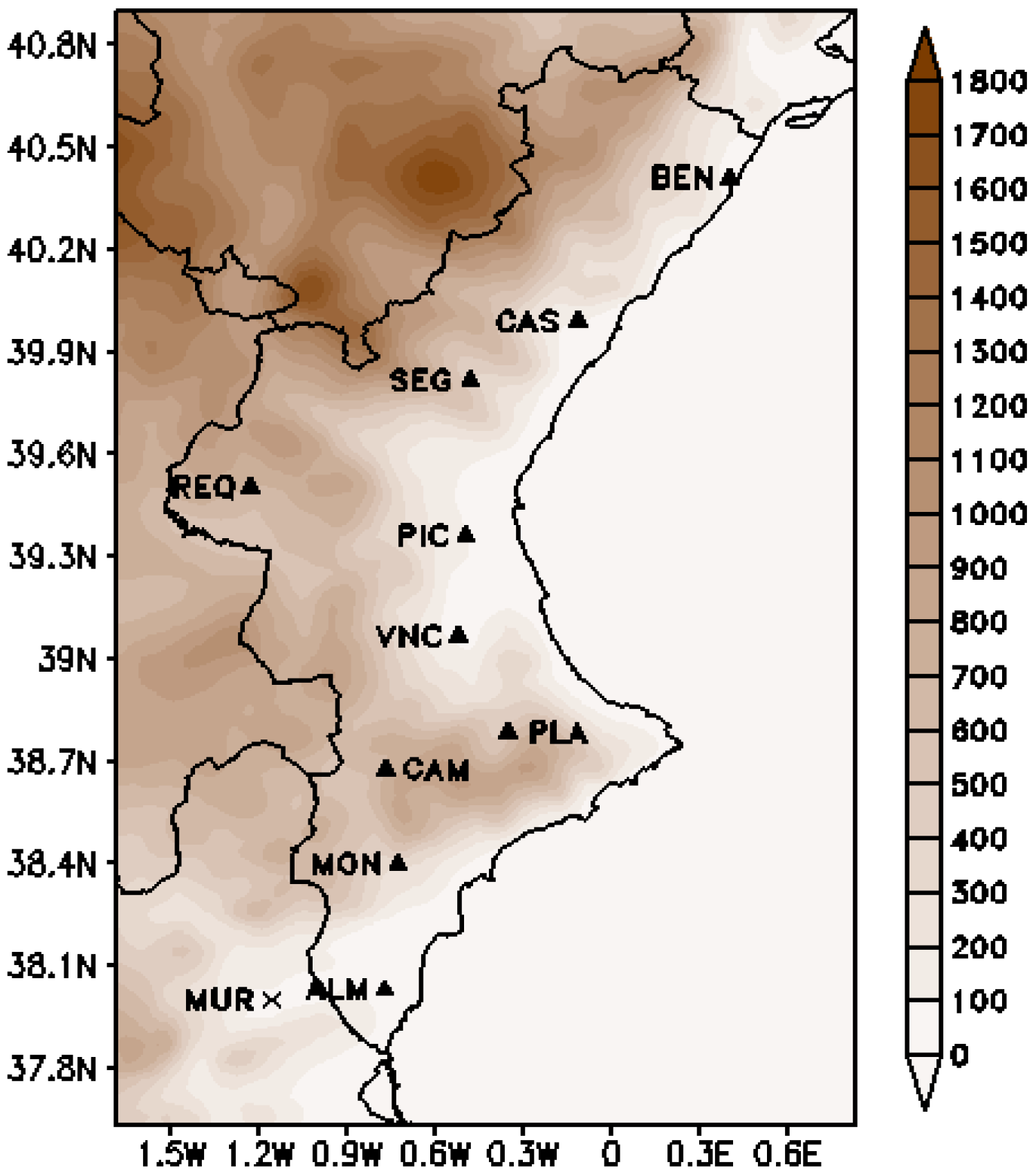
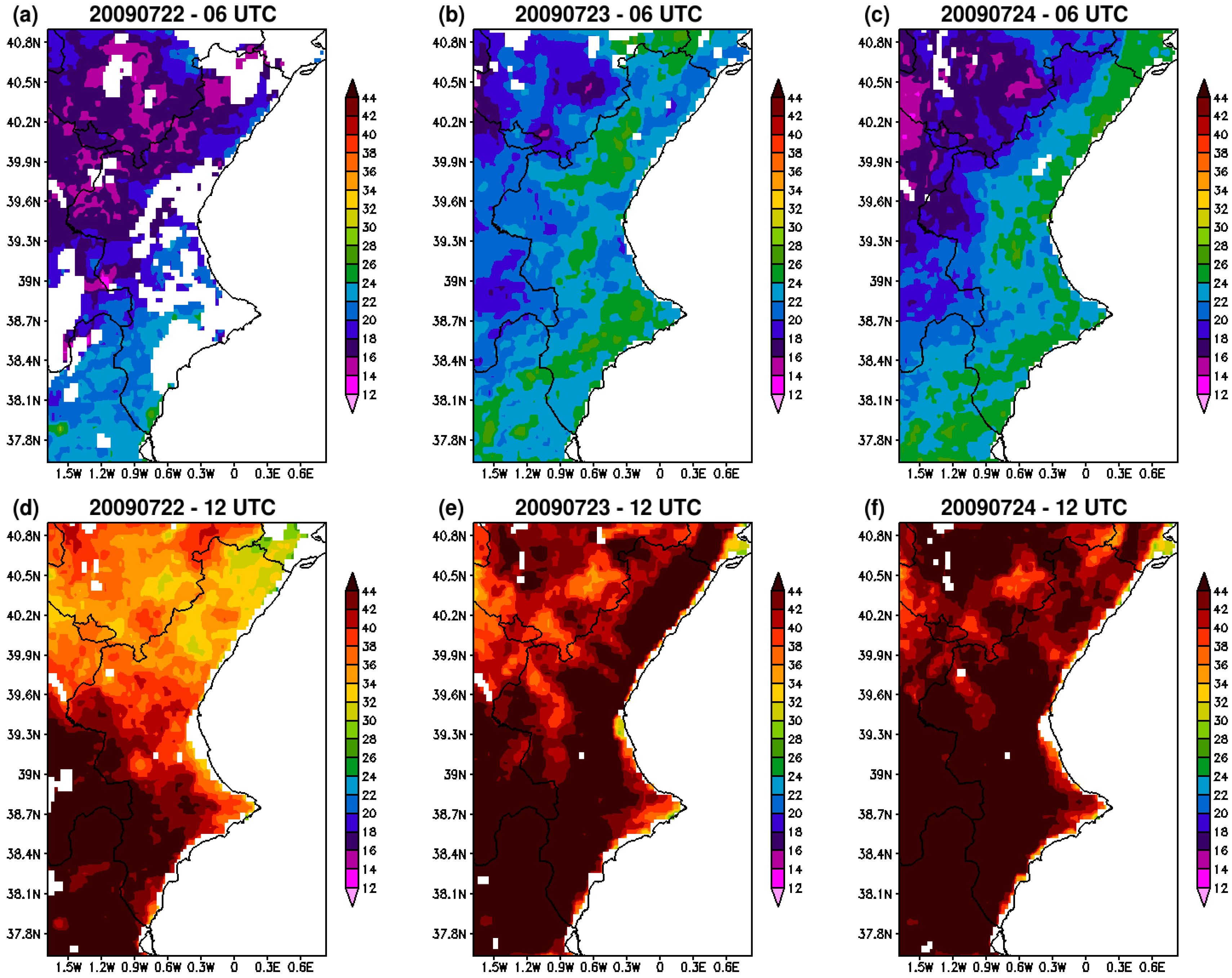
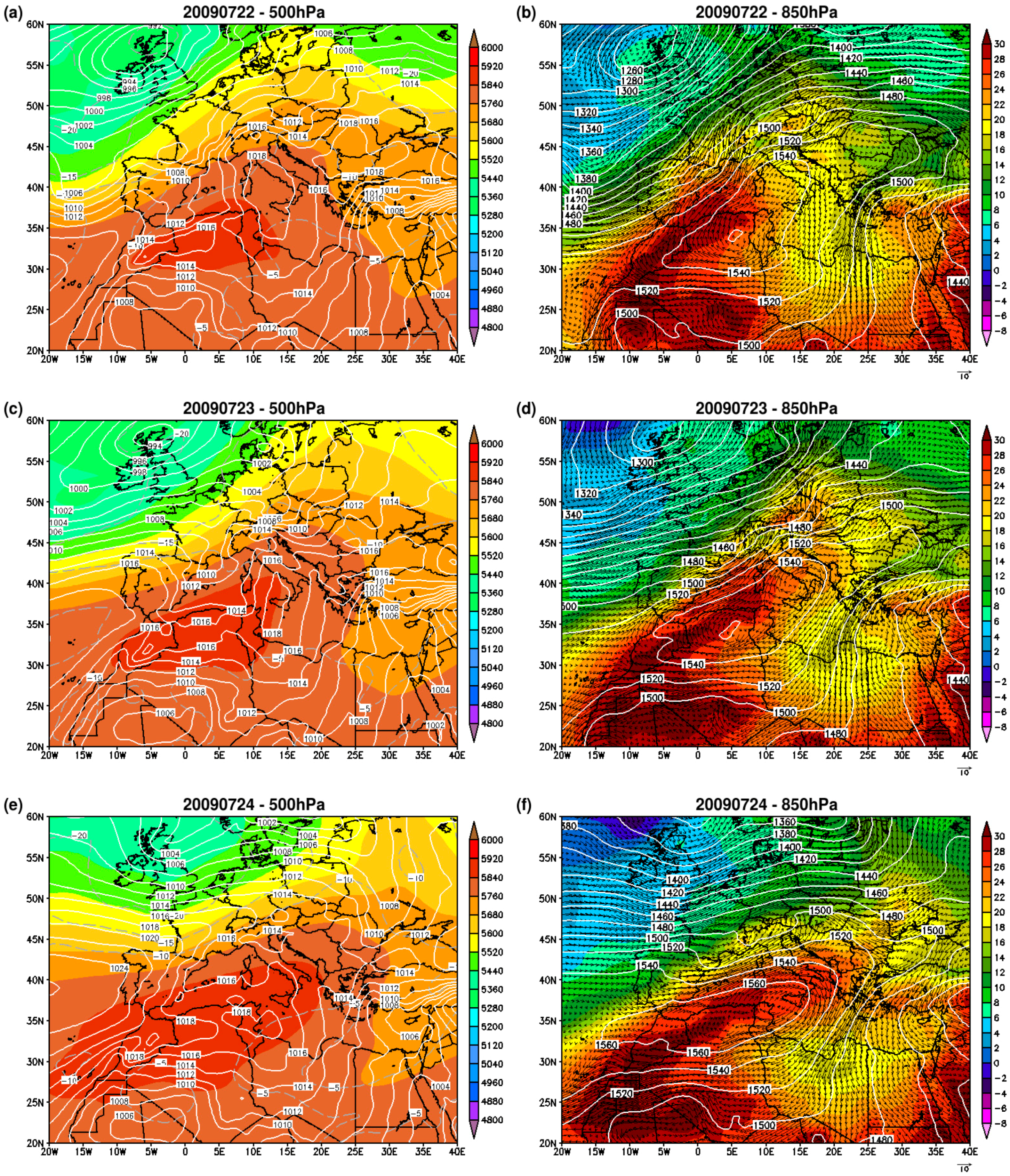
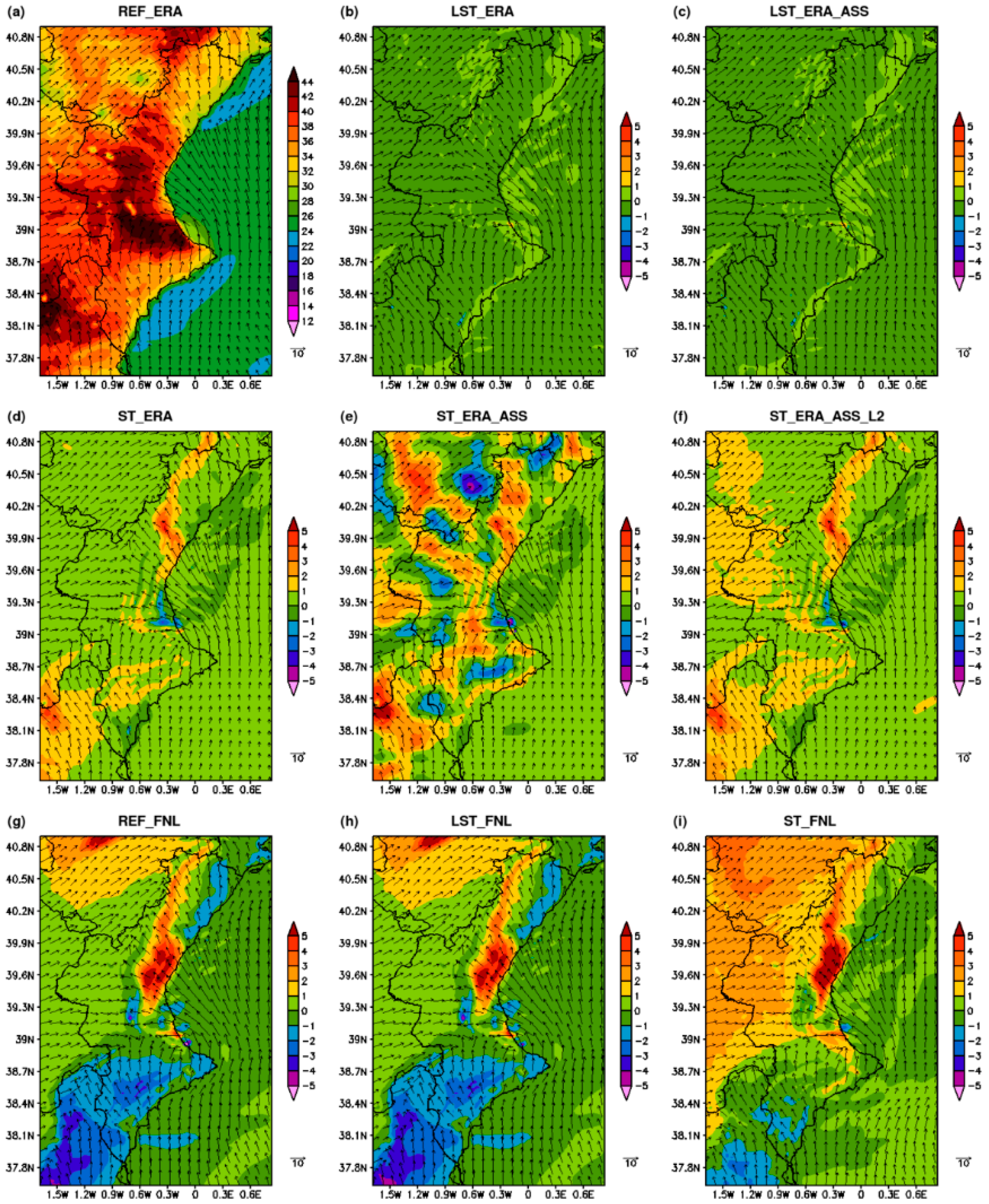
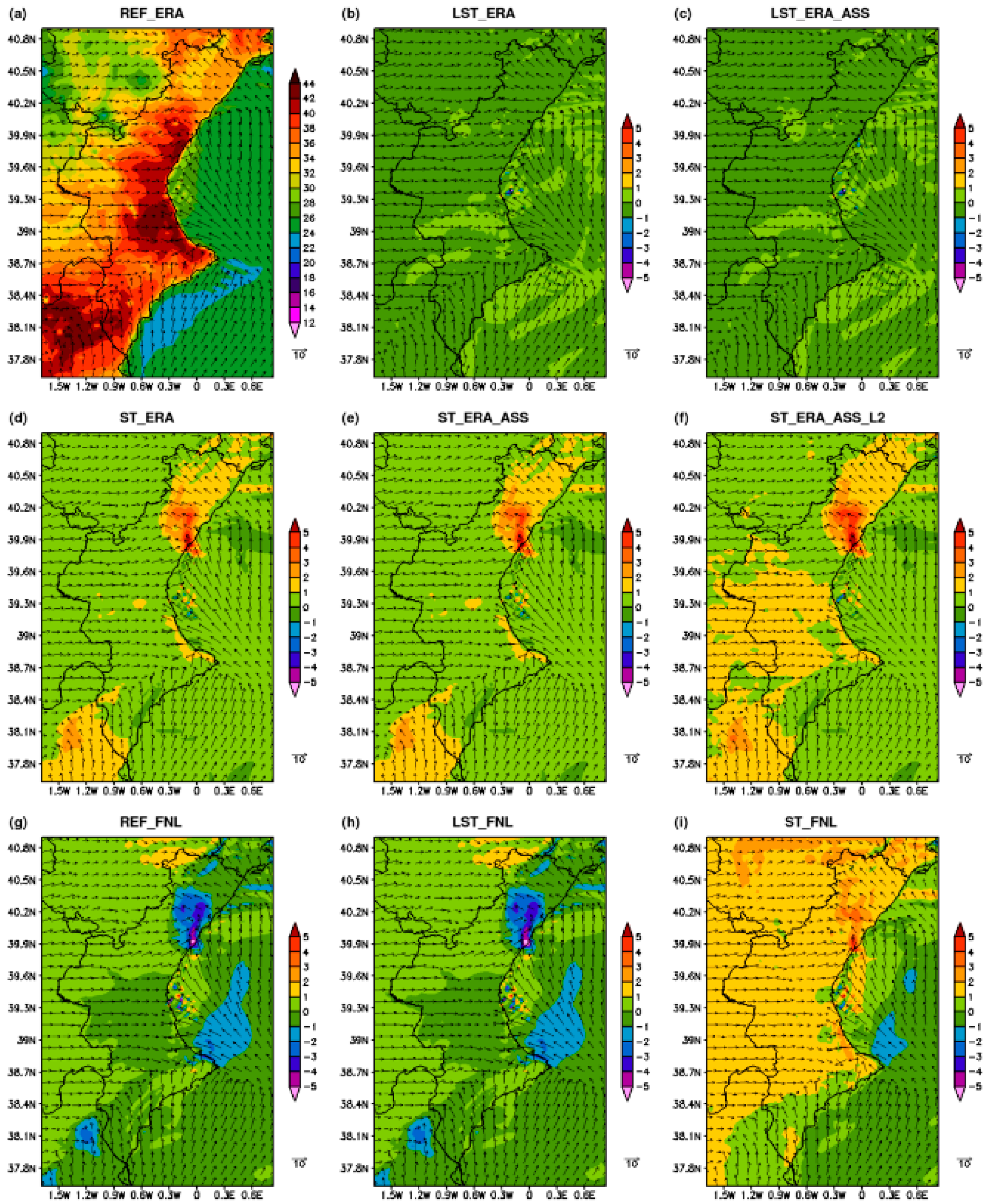
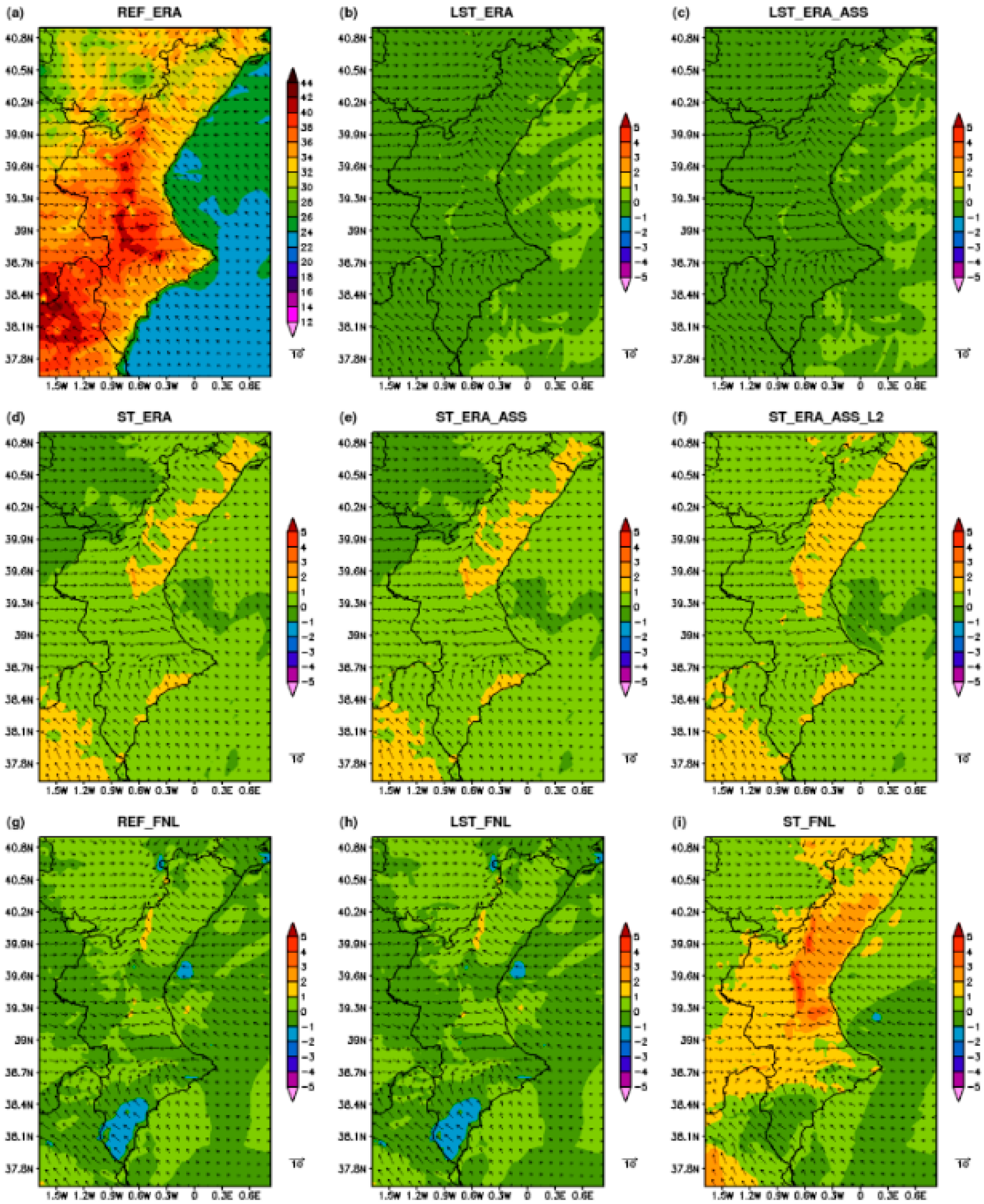
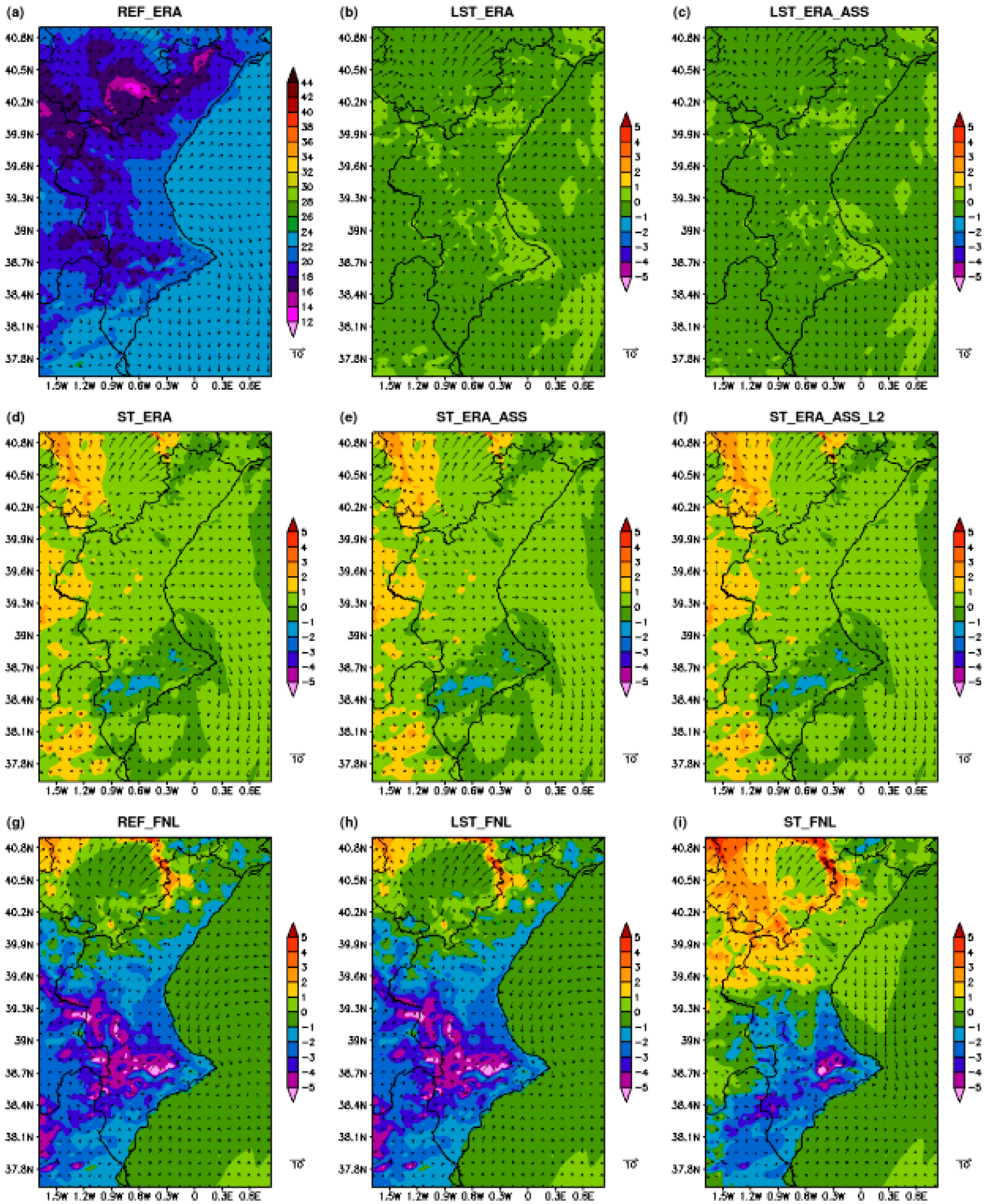
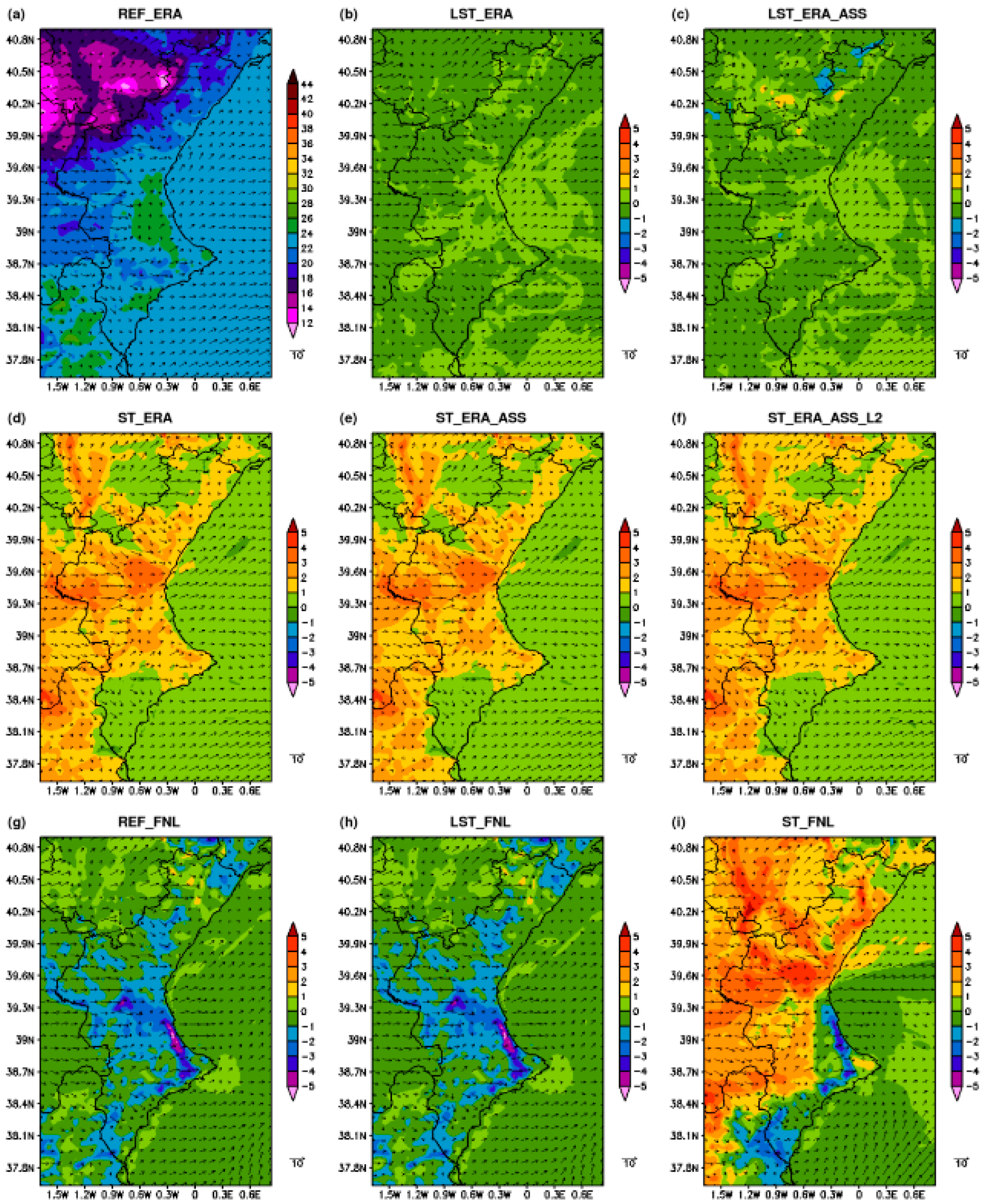
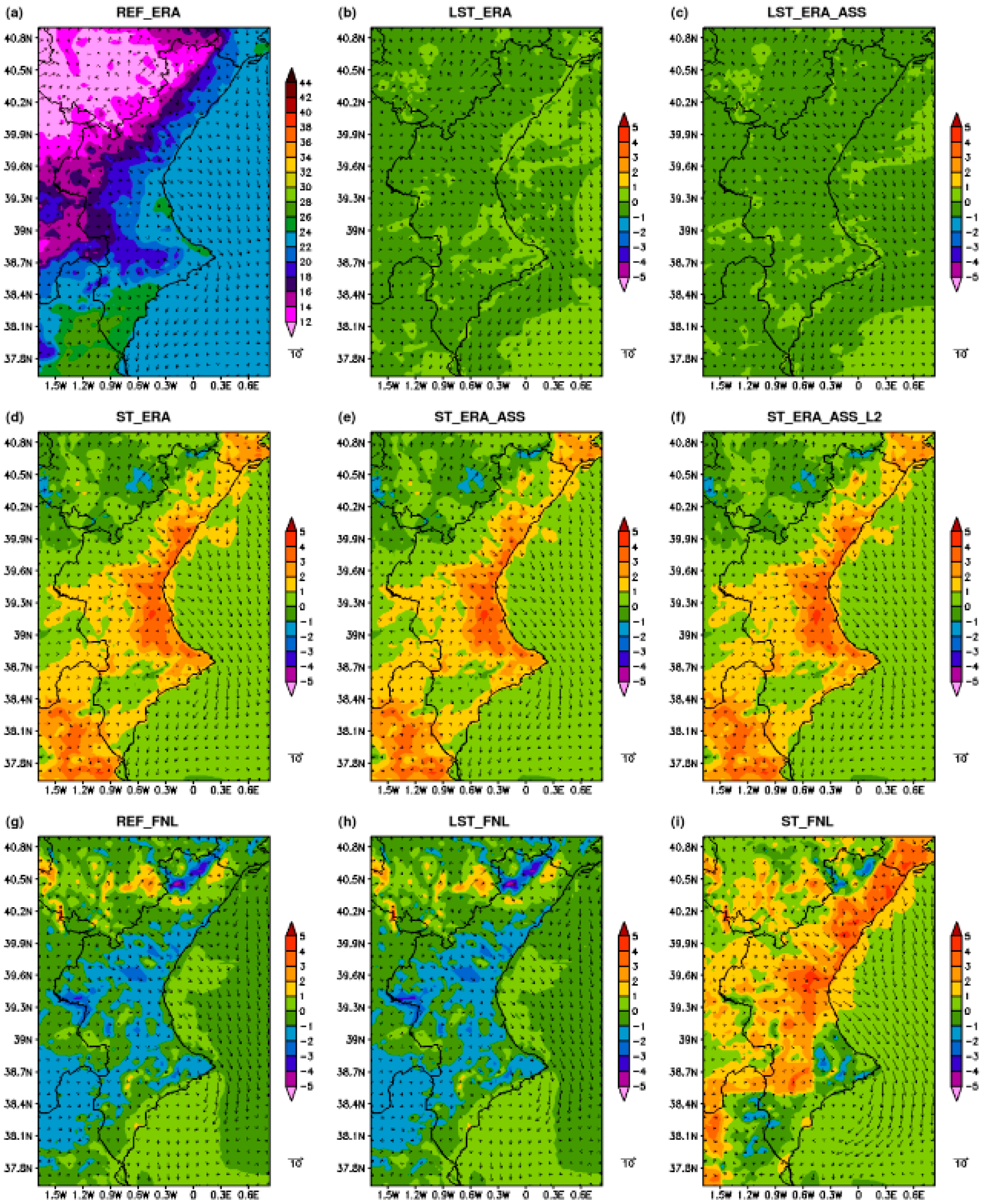
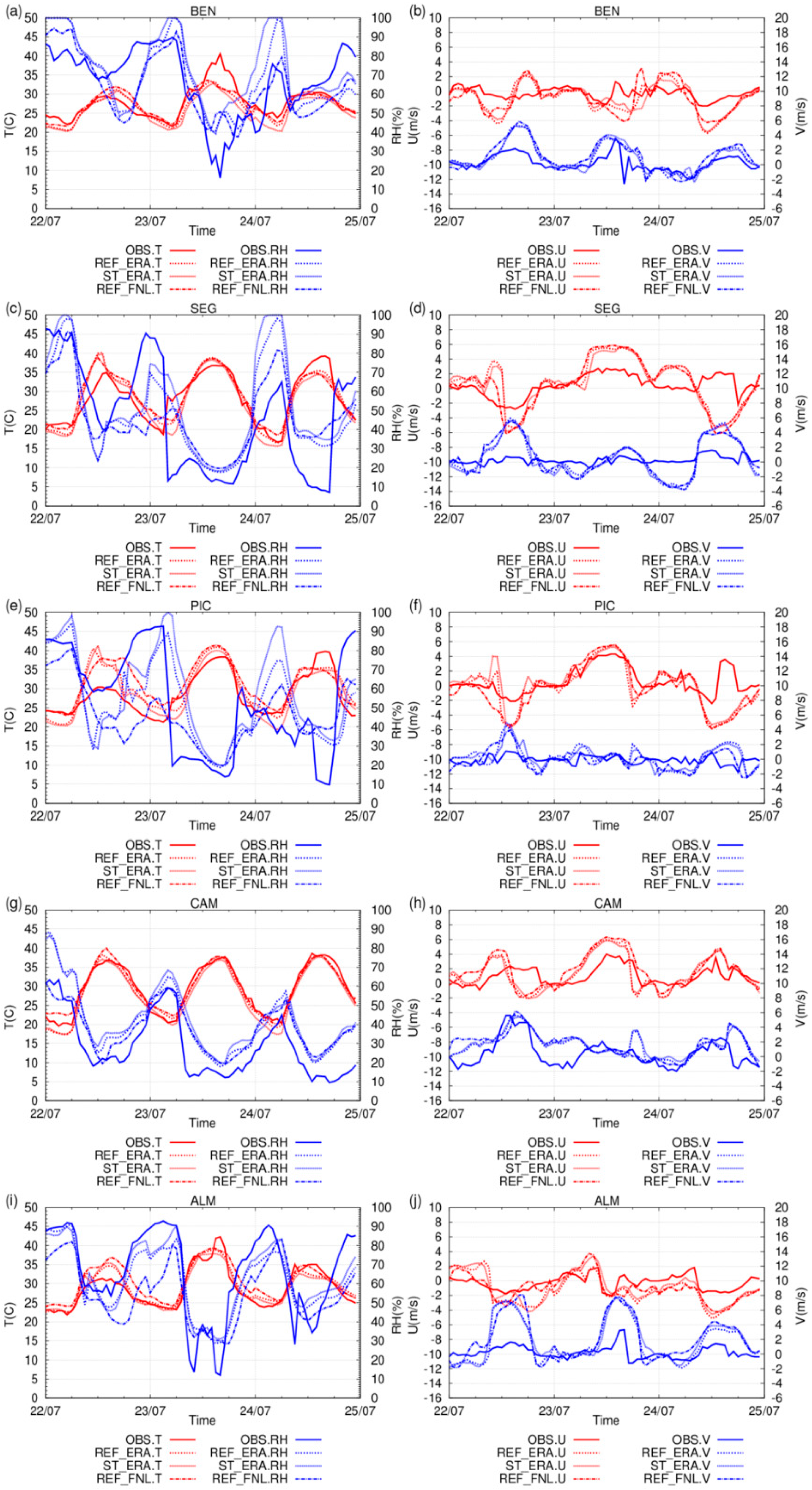

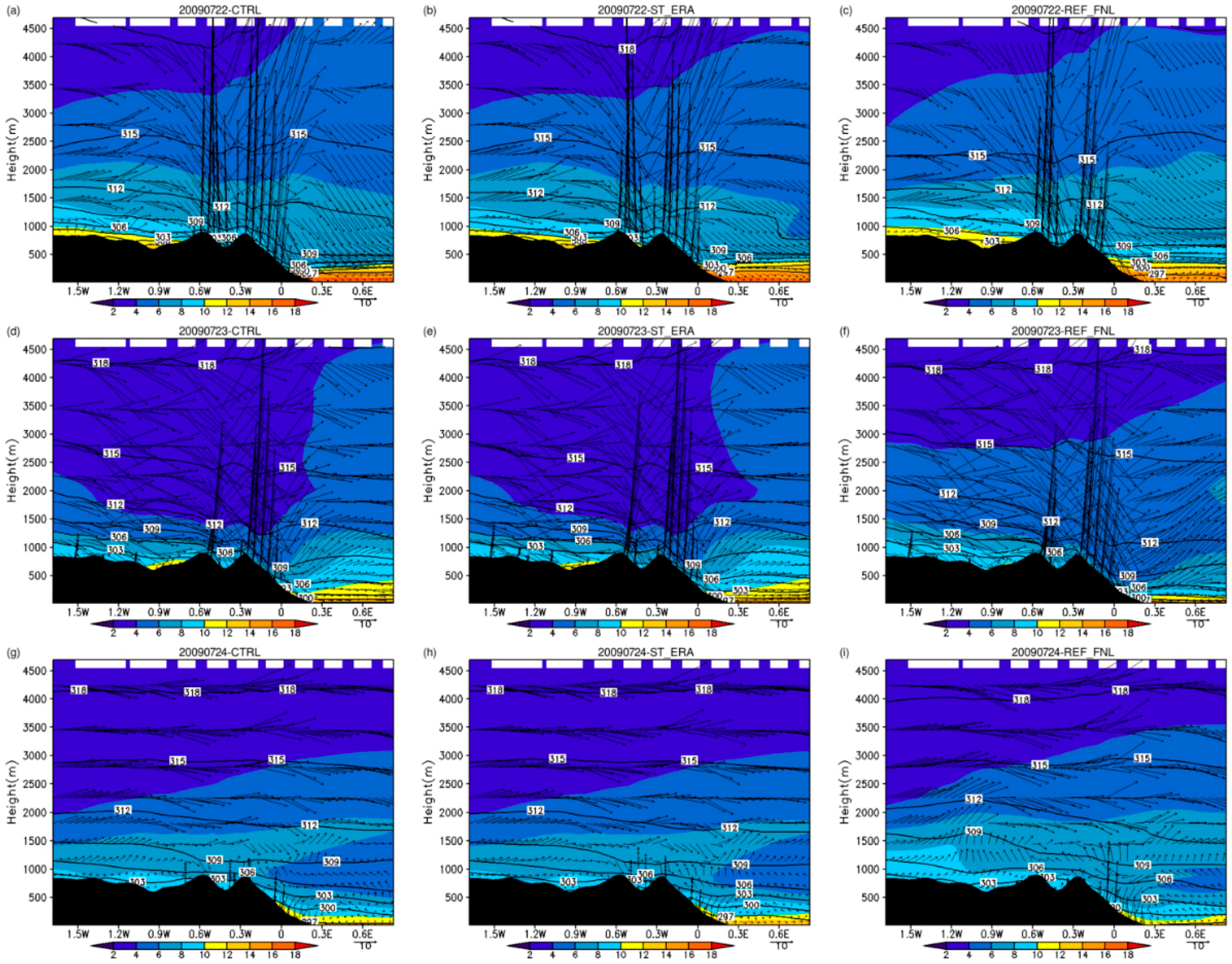
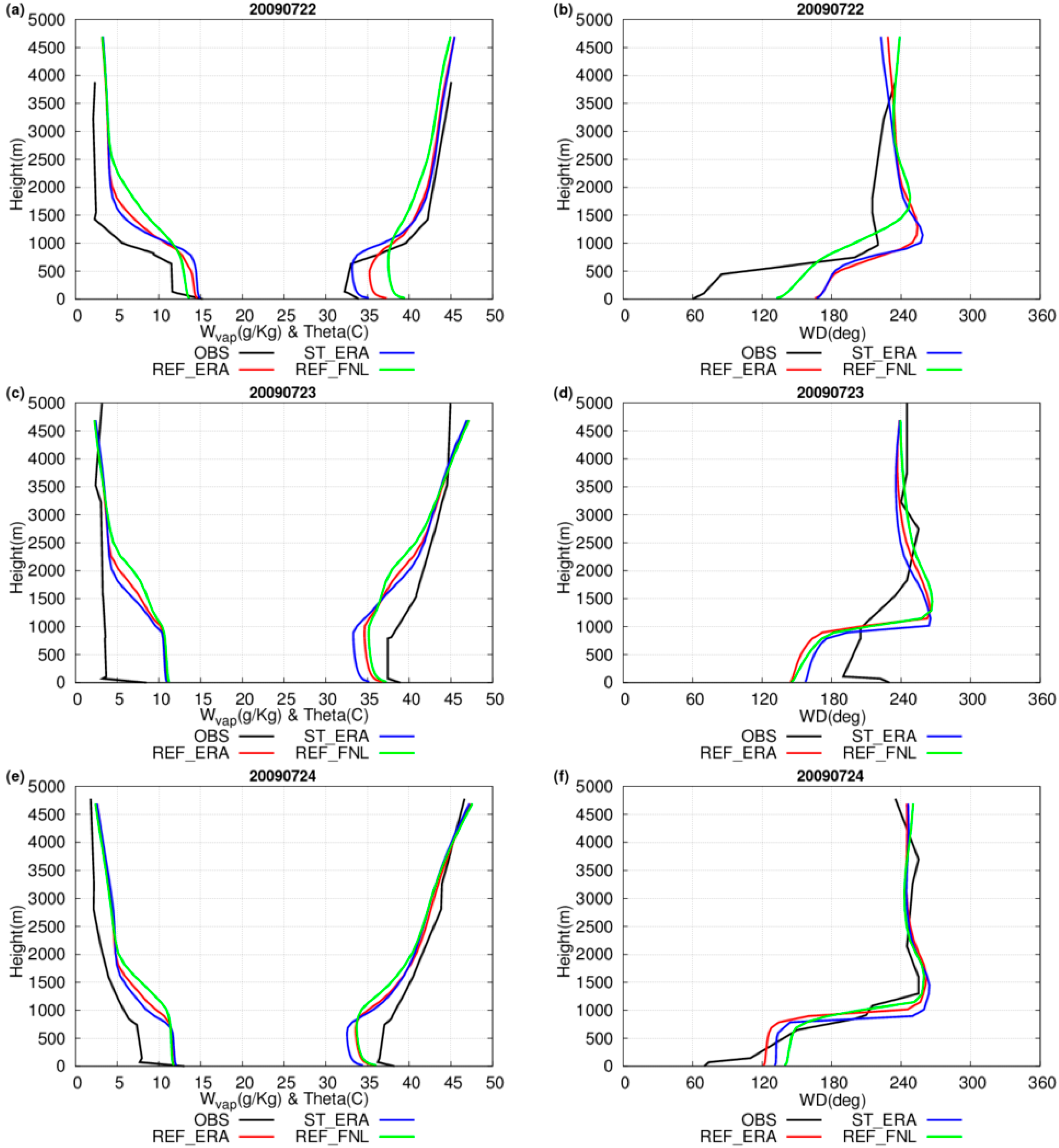

| Experiments | Meteorological Input Data | LST (D1, D2, D3) | ST (D1, D2, D3) | LST D3 Update | Soil Level Scheme |
|---|---|---|---|---|---|
| REF_ERA | ERA-Interim | - | - | - | L1 |
| LST_ERA | ERA-Interim | ERA-Interim | - | - | L1 |
| LST_ERA_ASS | ERA-Interim | ERA-Interim | - | MSG-SEVIRI | L1 |
| ST_ERA | ERA-Interim | ERA-Interim | ERA-Interim | - | L1 |
| ST_ERA_ASS | ERA-Interim | ERA-Interim | ERA-Interim | MSG-SEVIRI | L1 |
| ST_ERA_ASS_L2 | ERA-Interim | ERA-Interim | ERA-Interim | MSG-SEVIRI | L2 |
| REF_FNL | FNL | - | - | - | L1 |
| LST_FNL | FNL | FNL | - | - | L1 |
| ST_FNL | FNL | FNL | FNL | - | L1 |
| Maximum Temperatures (°C) | ||||
|---|---|---|---|---|
| Station | Acronym | 22 July | 23 July | 24 July |
| Bernicarló | BEN | 29.6 (0.2) | 40.6 (0.3) | 30.5 (0.3) |
| Castelló | CAS | 31.1 (0.3) | 39.9 (0.3) | 32.5 (0.3) |
| Segorbe | SEG | 34.9 (0.3) | 36.8 (0.3) | 39.3 (0.3) |
| Requena | REQ | 38.40 (0.10) | 31.30 (0.10) | 33.10 (0.10) |
| Picassent | PIC | 30.4 (0.3) | 38.3 (0.3) | 39.8 (0.3) |
| Vilanova de Castelló | VNC | 32.56 (0.10) | 40.79 (0.10) | 41.17 (0.10) |
| Planes | PLA | 39.69 (0.10) | 38.95 (0.10) | 39.53 (0.10) |
| Camp de Mirra | CAM | 36.8 (0.3) | 37.7 (0.3) | 38.7 (0.3) |
| Monforte del Cid | MON | 33.79 (0.10) | 40.42 (0.10) | 37.62 (0.10) |
| Almoradí | ALM | 31.37 (0.10) | 42.30 (0.10) | 35.13 (0.10) |
| Minimum Temperatures (°C) | ||||
|---|---|---|---|---|
| Station | Acronym | 22 July | 23 July | 24 July |
| Bernicarló | BEN | 22.1 (0.2) | 21.5 (0.2) | 23.8 (0.2) |
| Castelló | CAS | 21.6 (0.2) | 20.4 (0.2) | 22.0 (0.2) |
| Segorbe | SEG | 20.1 (0.2) | 18.8 (0.2) | 16.7 (0.2) |
| Requena | REQ | 16.40 (0.10) | 19.00 (0.10) | 14.40 (0.10) |
| Picassent | PIC | 22.8 (0.2) | 21.3 (0.2) | 22.9 (0.2) |
| Vilanova de Castelló | VNC | 22.70 (0.10) | 20.36 (0.10) | 19.28 (0.10) |
| Planes | PLA | 19.30 (0.10) | 25.92 (0.10) | 20.22 (0.10) |
| Camp de Mirra | CAM | 19.6 (0.2) | 20.6 (0.2) | 20.3 (0.2) |
| Monforte del Cid | MON | 20.48 (0.10) | 20.43 (0.10) | 21.31 (0.10) |
| Almoradí | ALM | 21.78 (0.10) | 23.16 (0.10) | 23.88 (0.10) |
| Inland Stations | Coastal Stations | All Stations | |||||||
|---|---|---|---|---|---|---|---|---|---|
| IoA | Bias | RMSE | IoA | Bias | RMSE | IoA | Bias | RMSE | |
| 20090722 | |||||||||
| REF_ERA | 0.5 | 4 | 6 | 0.3 | 5 | 6 | 0.5 | 5 | 6 |
| LST_ERA | 0.5 | 5 | 6 | 0.3 | 5 | 7 | 0.5 | 5 | 6 |
| LST_ERA_ASS | 0.5 | 5 | 6 | 0.3 | 5 | 7 | 0.5 | 5 | 6 |
| ST_ERA | 0.5 | 4 | 5 | 0.4 | 4 | 6 | 0.5 | 4 | 6 |
| ST_ERA_ASS | 0.6 | 3 | 5 | 0.4 | 4 | 6 | 0.5 | 4 | 5 |
| ST_ERA_ASS_L2 | 0.5 | 4 | 5 | 0.4 | 4 | 6 | 0.5 | 4 | 6 |
| REF_FNL | 0.5 | 5 | 6 | 0.4 | 4 | 6 | 0.6 | 5 | 6 |
| LST_FNL | 0.5 | 5 | 6 | 0.4 | 4 | 6 | 0.6 | 5 | 6 |
| ST_FNL | 0.6 | 4 | 5 | 0.5 | 4 | 5 | 0.6 | 4 | 5 |
| 20090723 | |||||||||
| REF_ERA | 0.8 | 1.4 | 2.3 | 0.16 | 0.5 | 4 | 0.6 | 0.9 | 3 |
| LST_ERA | 0.8 | 1.4 | 2.3 | 0.17 | 0.6 | 4 | 0.6 | 1.0 | 3 |
| LST_ERA_ASS | 0.8 | 1.4 | 2.3 | 0.17 | 0.6 | 4 | 0.6 | 1.0 | 3 |
| ST_ERA | 0.8 | 0.7 | 2.0 | 0.15 | −0.9 | 4 | 0.6 | −0.17 | 3 |
| ST_ERA_ASS | 0.8 | 0.7 | 2.0 | 0.15 | −0.9 | 4 | 0.6 | −0.17 | 3 |
| ST_ERA_ASS_L2 | 0.8 | 0.5 | 2.0 | 0.14 | −1.2 | 4 | 0.6 | −0.4 | 3 |
| REF_FNL | 0.8 | 1.5 | 2.3 | 0.19 | 1.1 | 4 | 0.6 | 1.3 | 3 |
| LST_FNL | 0.8 | 1.5 | 2.3 | 0.19 | 1.1 | 4 | 0.6 | 1.3 | 3 |
| ST_FNL | 0.8 | 0.08 | 1.9 | 0.16 | −1.1 | 4 | 0.6 | −0.6 | 3 |
| 20090724 | |||||||||
| REF_ERA | 0.8 | −1.1 | 2.2 | 0.9 | −1.2 | 1.7 | 0.9 | −1.1 | 2.0 |
| LST_ERA | 0.8 | −1.0 | 2.1 | 0.9 | −1.1 | 1.7 | 0.9 | −1.0 | 1.9 |
| LST_ERA_ASS | 0.8 | −1.0 | 2.1 | 0.9 | −1.1 | 1.7 | 0.9 | −1.0 | 1.9 |
| ST_ERA | 0.8 | −1.8 | 3 | 0.9 | −2.0 | 2.3 | 0.9 | −1.9 | 2.5 |
| ST_ERA_ASS | 0.8 | −1.8 | 3 | 0.9 | −2.0 | 2.3 | 0.9 | −1.9 | 2.5 |
| ST_ERA_ASS_L2 | 0.8 | −2.0 | 3 | 0.8 | −2.2 | 2.5 | 0.8 | −2.1 | 3 |
| REF_FNL | 0.8 | −1.0 | 2.1 | 0.9 | −0.9 | 1.4 | 0.9 | −0.9 | 1.8 |
| LST_FNL | 0.8 | −1.0 | 2.2 | 0.9 | −0.8 | 1.4 | 0.9 | −0.9 | 1.8 |
| ST_FNL | 0.7 | −3 | 3 | 0.8 | −3 | 3 | 0.8 | −3 | 3 |
| Inland Stations | Coastal Stations | All Stations | |||||||
|---|---|---|---|---|---|---|---|---|---|
| IoA | Bias | RMSE | IoA | Bias | RMSE | IoA | Bias | RMSE | |
| 20090722 | |||||||||
| REF_ERA | 0.6 | −0.7 | 1.5 | 0.23 | −0.6 | 1.4 | 0.7 | −0.7 | 1.4 |
| LST_ERA | 0.6 | −0.7 | 1.5 | 0.25 | −0.6 | 1.4 | 0.7 | −0.6 | 1.4 |
| LST_ERA_ASS | 0.6 | −0.7 | 1.5 | 0.25 | −0.6 | 1.4 | 0.7 | −0.6 | 1.4 |
| ST_ERA | 0.7 | −0.8 | 1.5 | 0.19 | −0.8 | 1.6 | 0.6 | −0.8 | 1.6 |
| ST_ERA_ASS | 0.7 | −0.8 | 1.5 | 0.19 | −0.8 | 1.6 | 0.6 | −0.8 | 1.6 |
| ST_ERA_ASS_L2 | 0.7 | −0.9 | 1.5 | 0.19 | −0.8 | 1.6 | 0.6 | −0.8 | 1.6 |
| REF_FNL | 0.4 | 2.0 | 3 | 0.4 | 1.4 | 1.8 | 0.4 | 1.7 | 2.2 |
| LST_FNL | 0.4 | 2.0 | 3 | 0.4 | 1.4 | 1.9 | 0.4 | 1.7 | 2.2 |
| ST_FNL | 0.5 | 0.5 | 2.2 | 0.3 | 0.3 | 2.0 | 0.5 | 0.4 | 2.1 |
| 20090723 | |||||||||
| REF_ERA | 0.5 | 2.1 | 3 | 0.4 | 2.4 | 3 | 0.5 | 2.2 | 3 |
| LST_ERA | 0.5 | 2.1 | 3 | 0.4 | 2.5 | 3 | 0.5 | 2.3 | 3 |
| LST_ERA_ASS | 0.5 | 2.1 | 3 | 0.4 | 2.5 | 3 | 0.5 | 2.3 | 3 |
| ST_ERA | 0.7 | 0.2 | 1.8 | 0.6 | 1.1 | 1.7 | 0.7 | 0.7 | 1.8 |
| ST_ERA_ASS | 0.7 | 0.2 | 1.8 | 0.6 | 1.1 | 1.7 | 0.7 | 0.7 | 1.8 |
| ST_ERA_ASS_L2 | 0.7 | 0.2 | 1.8 | 0.6 | 1.1 | 1.7 | 0.7 | 0.6 | 1.7 |
| REF_FNL | 0.4 | 3 | 4 | 0.3 | 4 | 4 | 0.3 | 3 | 4 |
| LST_FNL | 0.4 | 3 | 4 | 0.3 | 4 | 4 | 0.3 | 3 | 4 |
| ST_FNL | 0.7 | 0.4 | 2.3 | 0.5 | 2.0 | 3 | 0.6 | 1.2 | 3 |
| 20090724 | |||||||||
| REF_ERA | 0.7 | 1.1 | 2.4 | 0.4 | 2.2 | 3 | 0.6 | 1.6 | 3 |
| LST_ERA | 0.7 | 1.1 | 2.4 | 0.4 | 2.2 | 3 | 0.6 | 1.7 | 3 |
| LST_ERA_ASS | 0.7 | 1.1 | 2.4 | 0.4 | 2.2 | 3 | 0.6 | 1.7 | 3 |
| ST_ERA | 0.7 | −0.7 | 3 | 0.6 | −0.5 | 3 | 0.7 | −0.6 | 3 |
| ST_ERA_ASS | 0.7 | −0.7 | 3 | 0.6 | −0.4 | 3 | 0.7 | −0.6 | 3 |
| ST_ERA_ASS_L2 | 0.7 | −0.8 | 3 | 0.6 | −0.5 | 3 | 0.7 | −0.6 | 3 |
| REF_FNL | 0.6 | 2.1 | 3 | 0.4 | 3 | 4 | 0.5 | 3 | 4 |
| LST_FNL | 0.6 | 2.1 | 3 | 0.4 | 3 | 4 | 0.5 | 3 | 4 |
| ST_FNL | 0.7 | −0.5 | 3 | 0.5 | 0.3 | 3 | 0.6 | −0.09 | 3 |
© 2016 by the authors; licensee MDPI, Basel, Switzerland. This article is an open access article distributed under the terms and conditions of the Creative Commons Attribution (CC-BY) license (http://creativecommons.org/licenses/by/4.0/).
Share and Cite
Gómez, I.; Caselles, V.; Estrela, M.J.; Niclòs, R. Impact of Initial Soil Temperature Derived from Remote Sensing and Numerical Weather Prediction Datasets on the Simulation of Extreme Heat Events. Remote Sens. 2016, 8, 589. https://doi.org/10.3390/rs8070589
Gómez I, Caselles V, Estrela MJ, Niclòs R. Impact of Initial Soil Temperature Derived from Remote Sensing and Numerical Weather Prediction Datasets on the Simulation of Extreme Heat Events. Remote Sensing. 2016; 8(7):589. https://doi.org/10.3390/rs8070589
Chicago/Turabian StyleGómez, Igor, Vicente Caselles, María José Estrela, and Raquel Niclòs. 2016. "Impact of Initial Soil Temperature Derived from Remote Sensing and Numerical Weather Prediction Datasets on the Simulation of Extreme Heat Events" Remote Sensing 8, no. 7: 589. https://doi.org/10.3390/rs8070589
APA StyleGómez, I., Caselles, V., Estrela, M. J., & Niclòs, R. (2016). Impact of Initial Soil Temperature Derived from Remote Sensing and Numerical Weather Prediction Datasets on the Simulation of Extreme Heat Events. Remote Sensing, 8(7), 589. https://doi.org/10.3390/rs8070589






